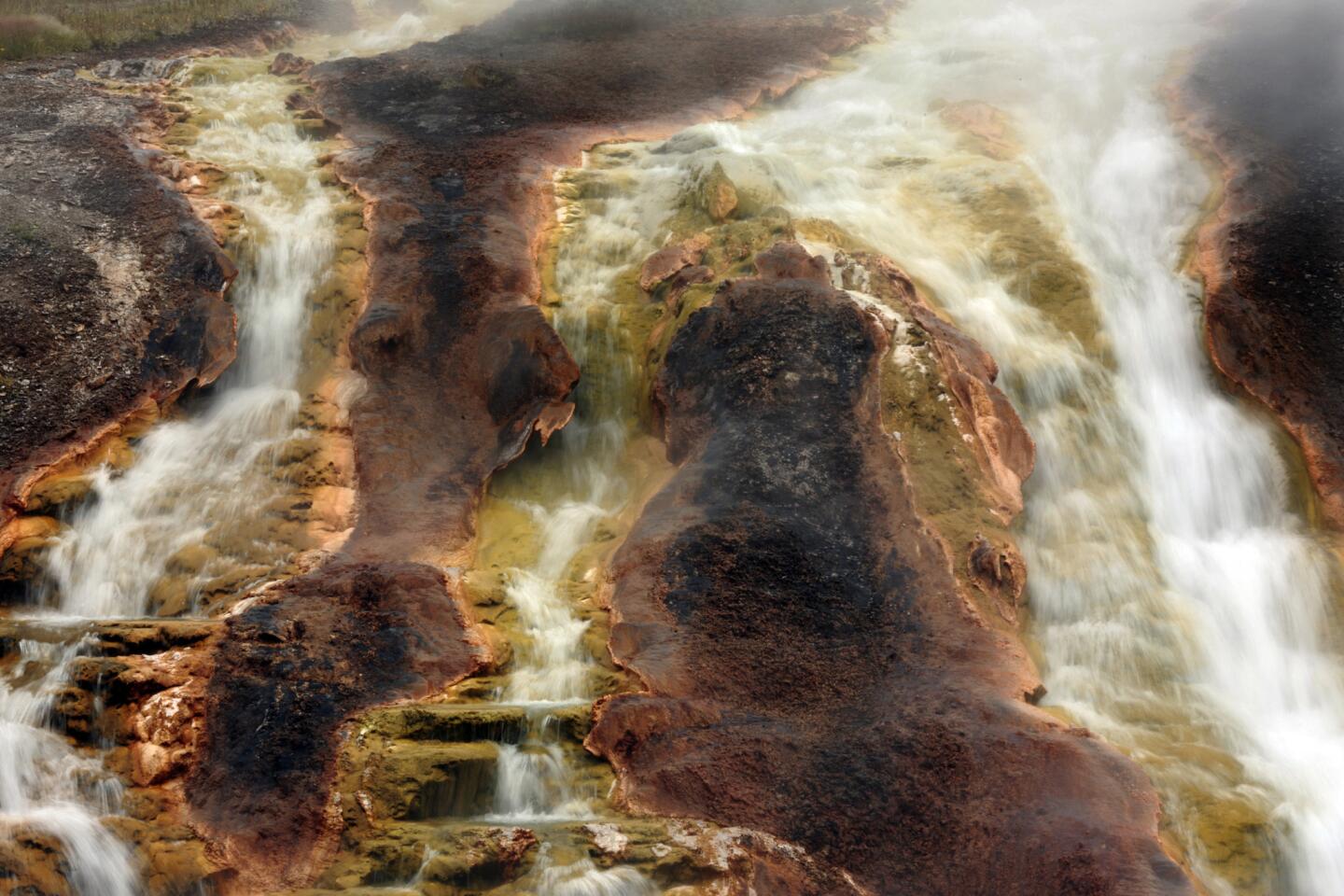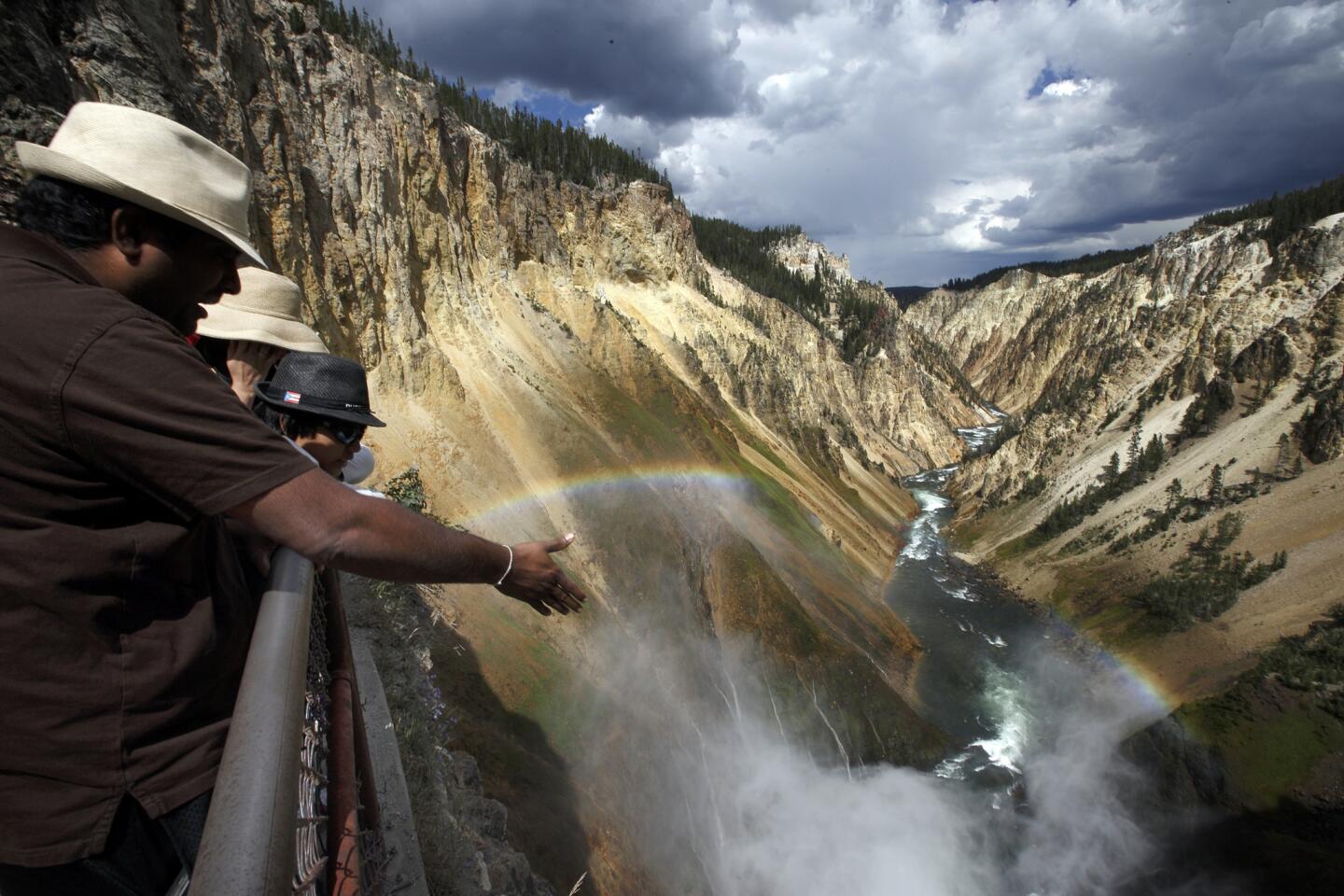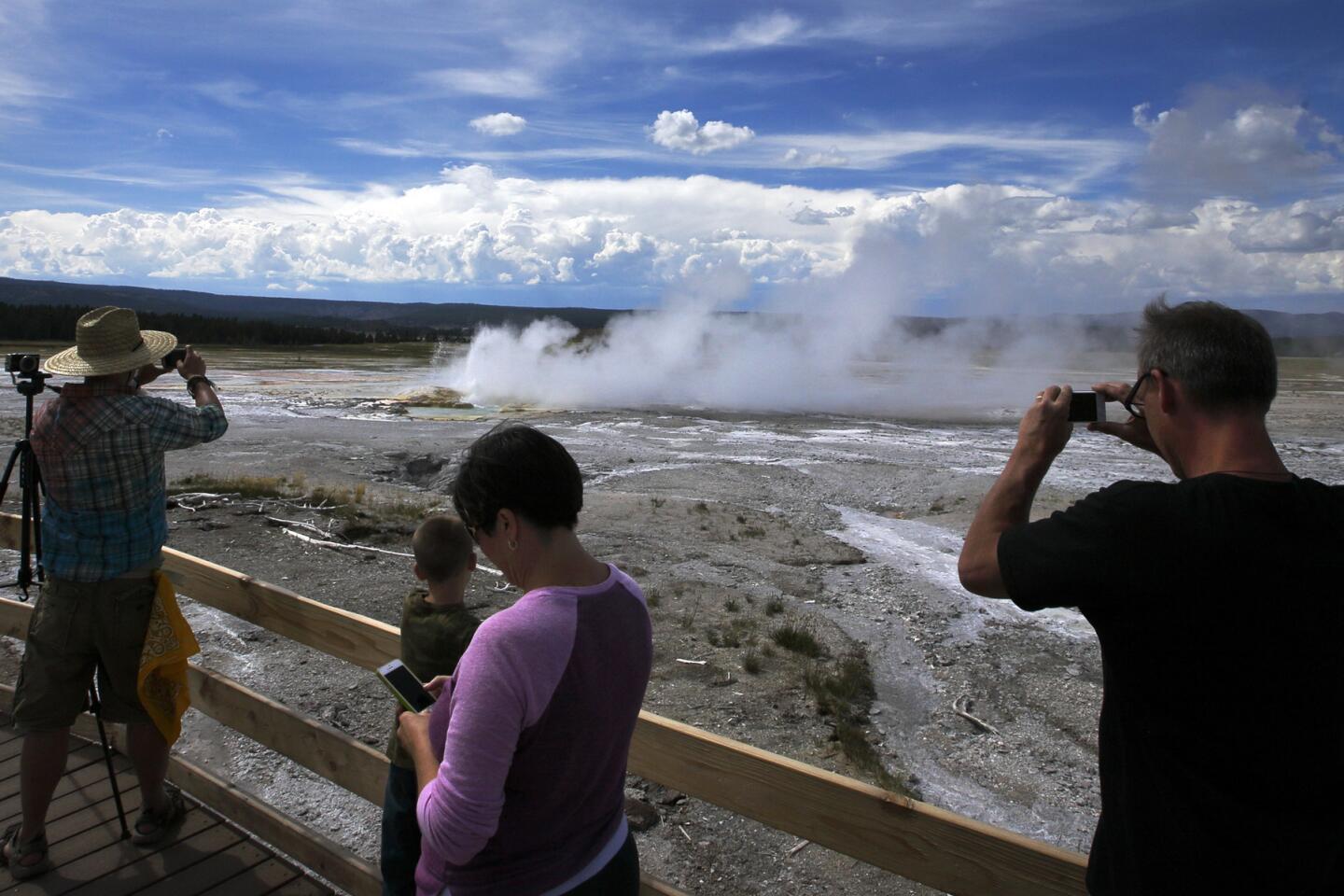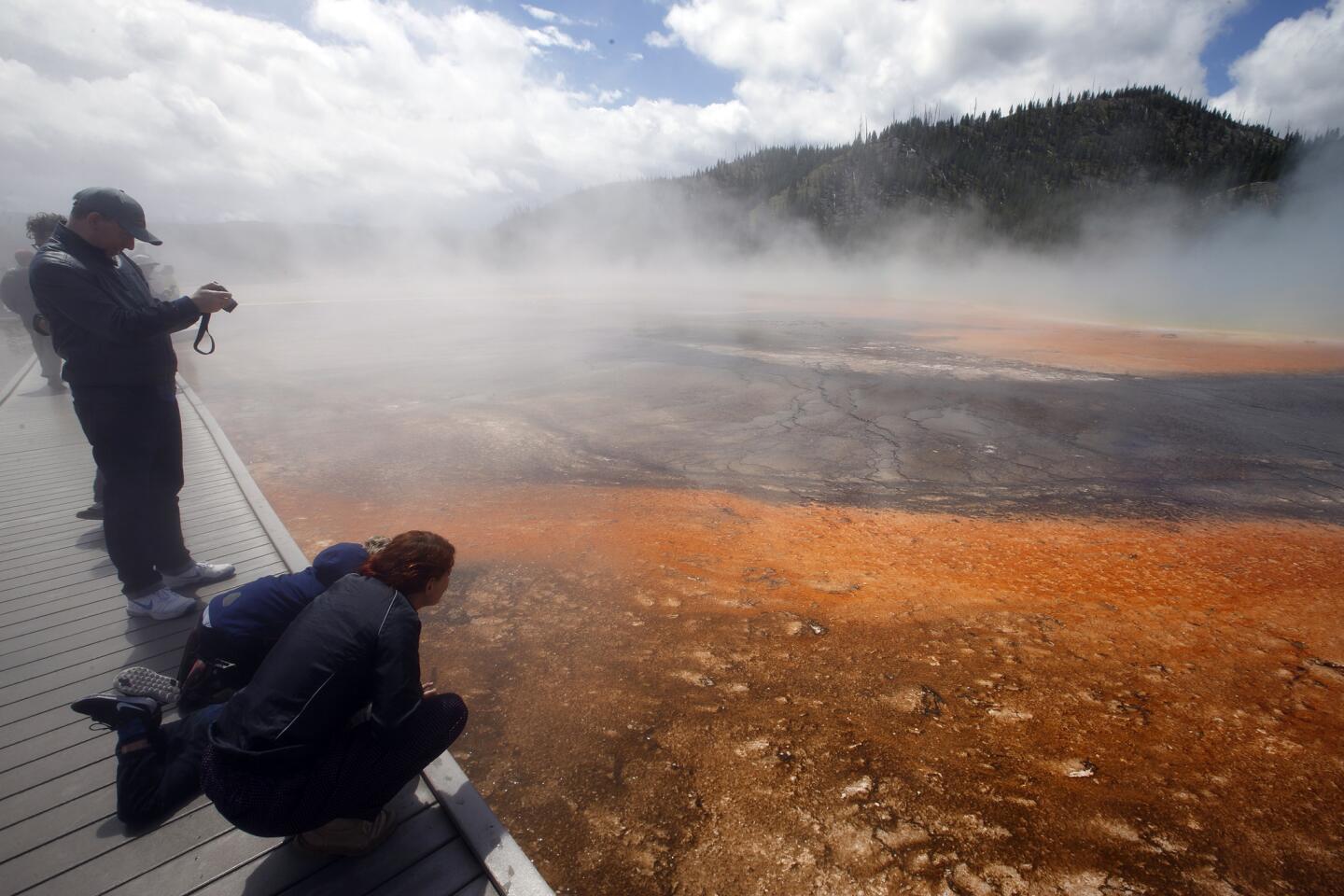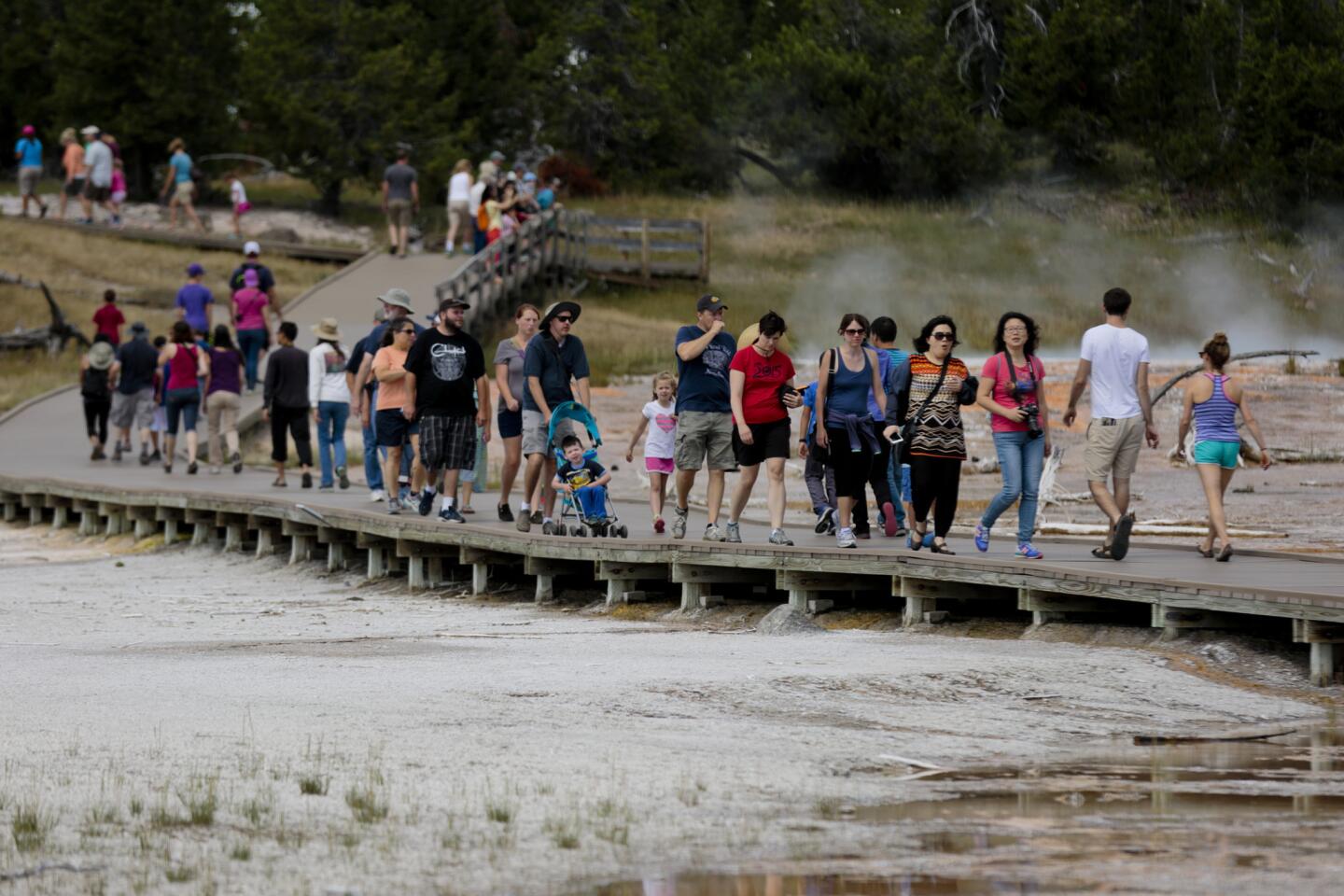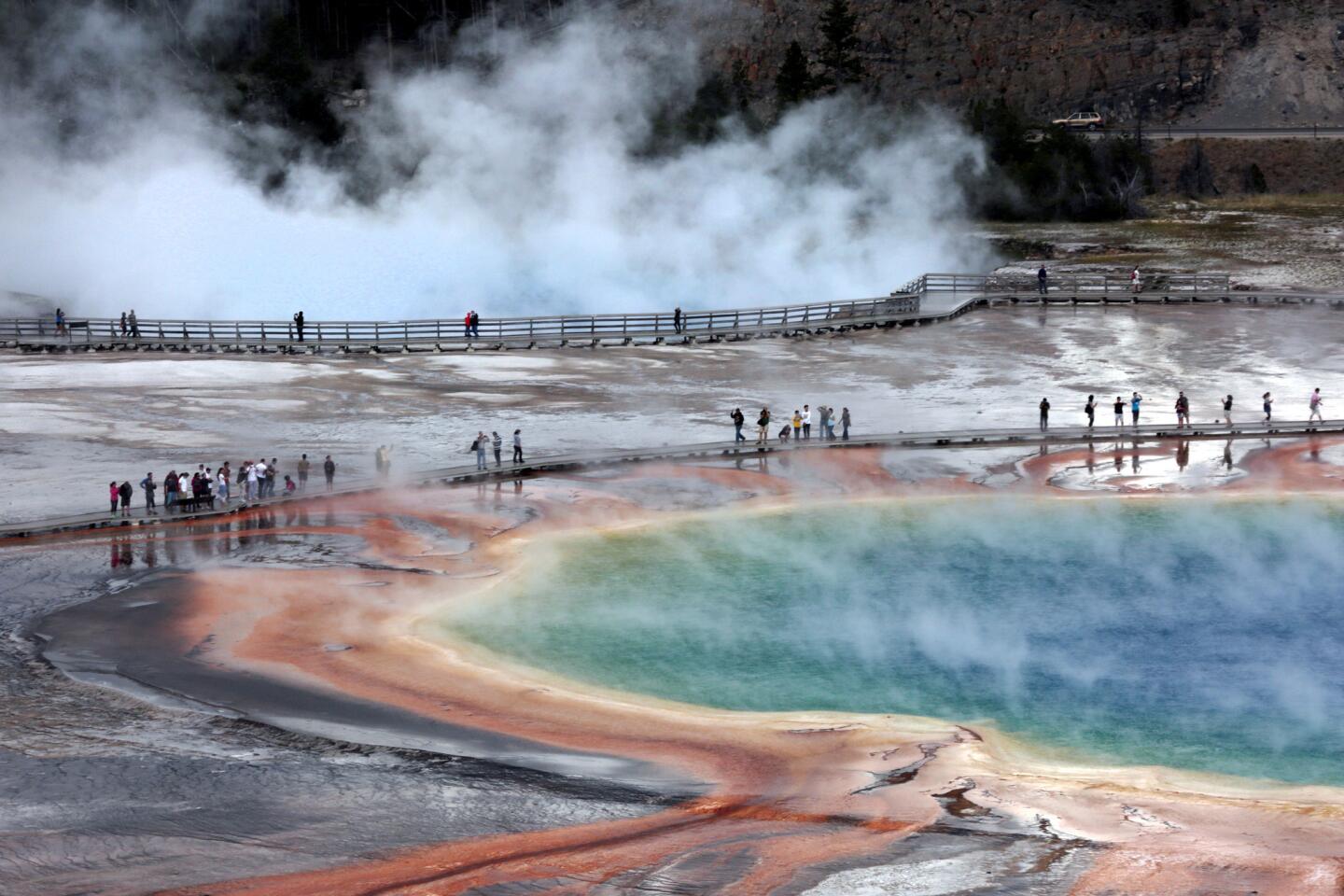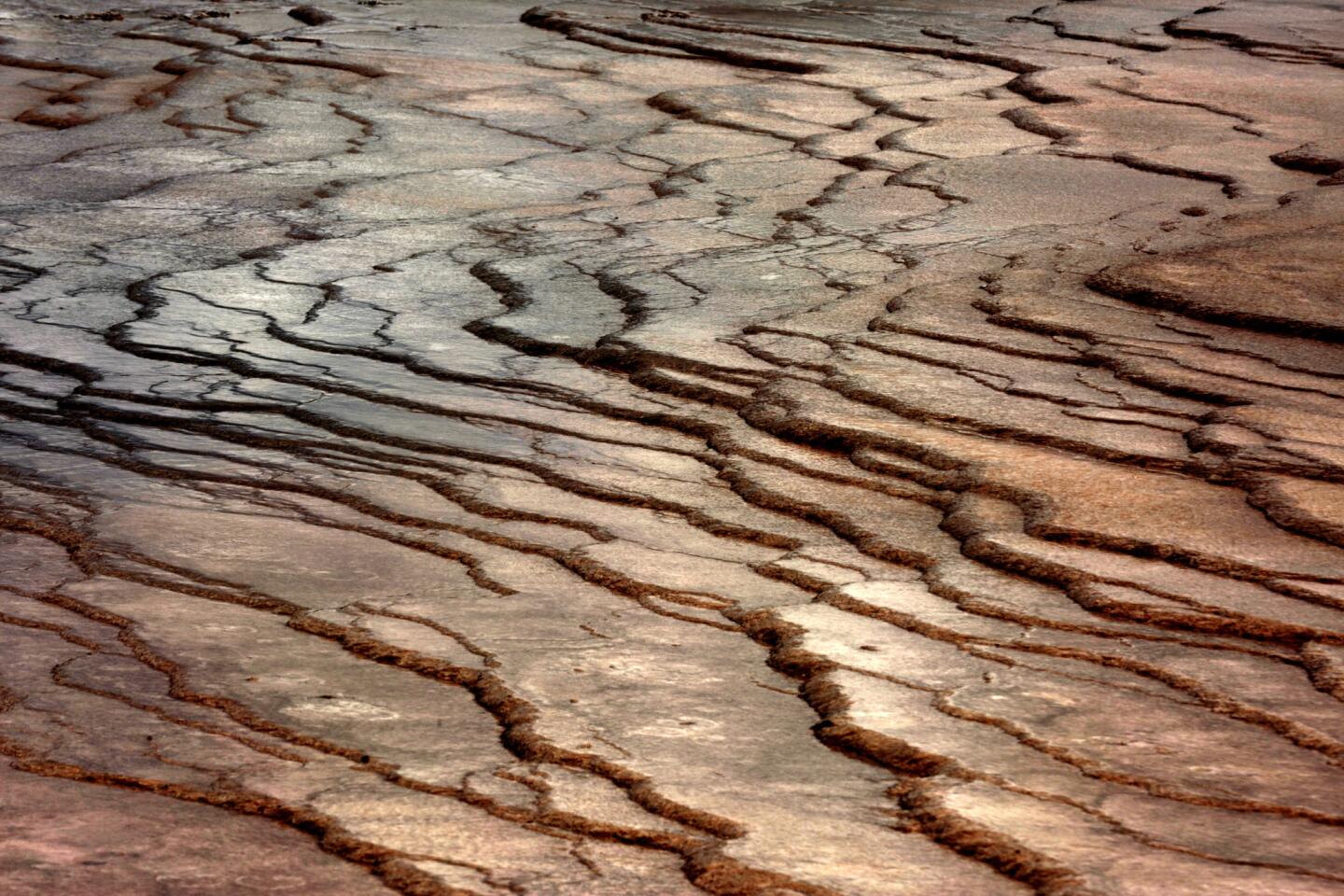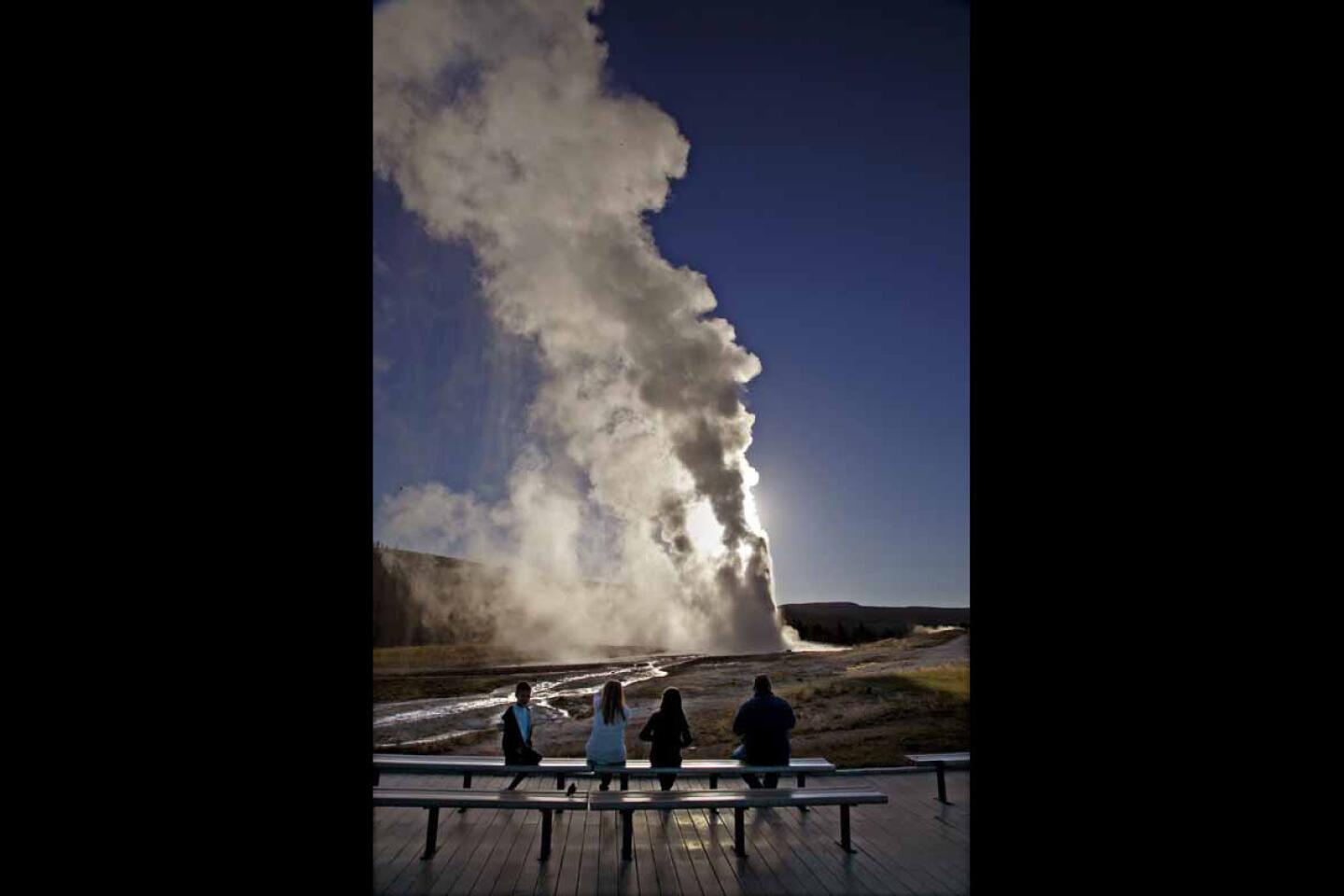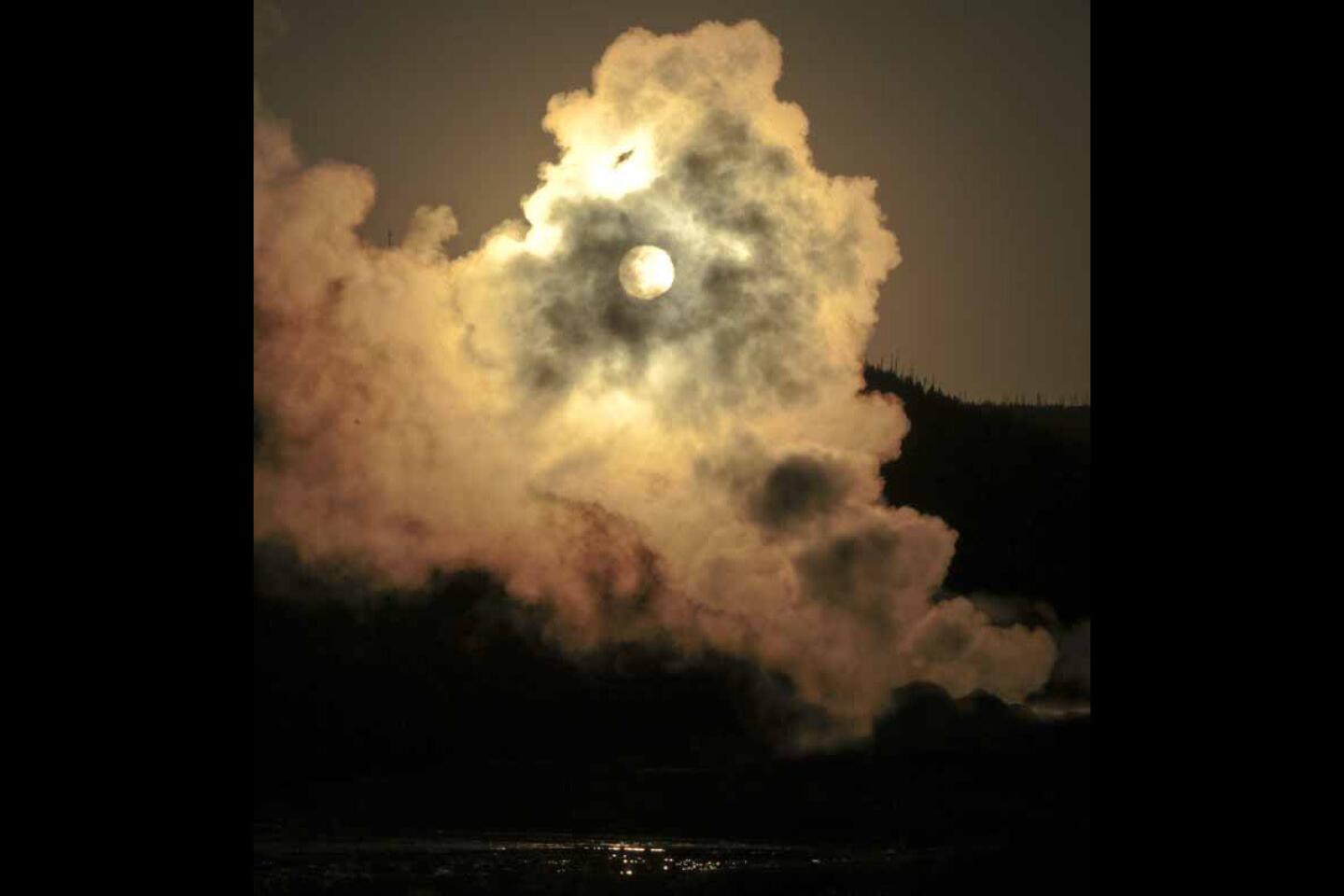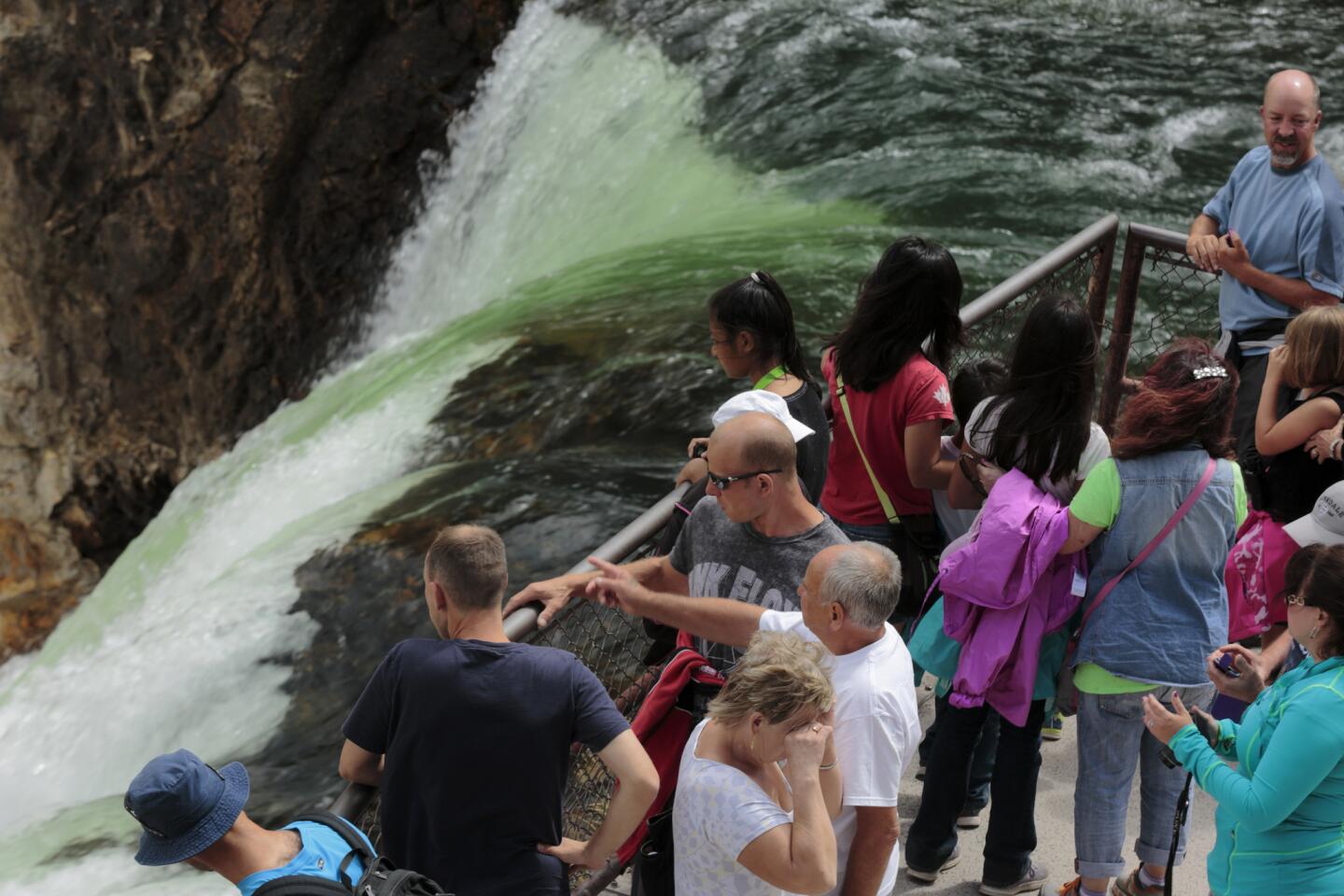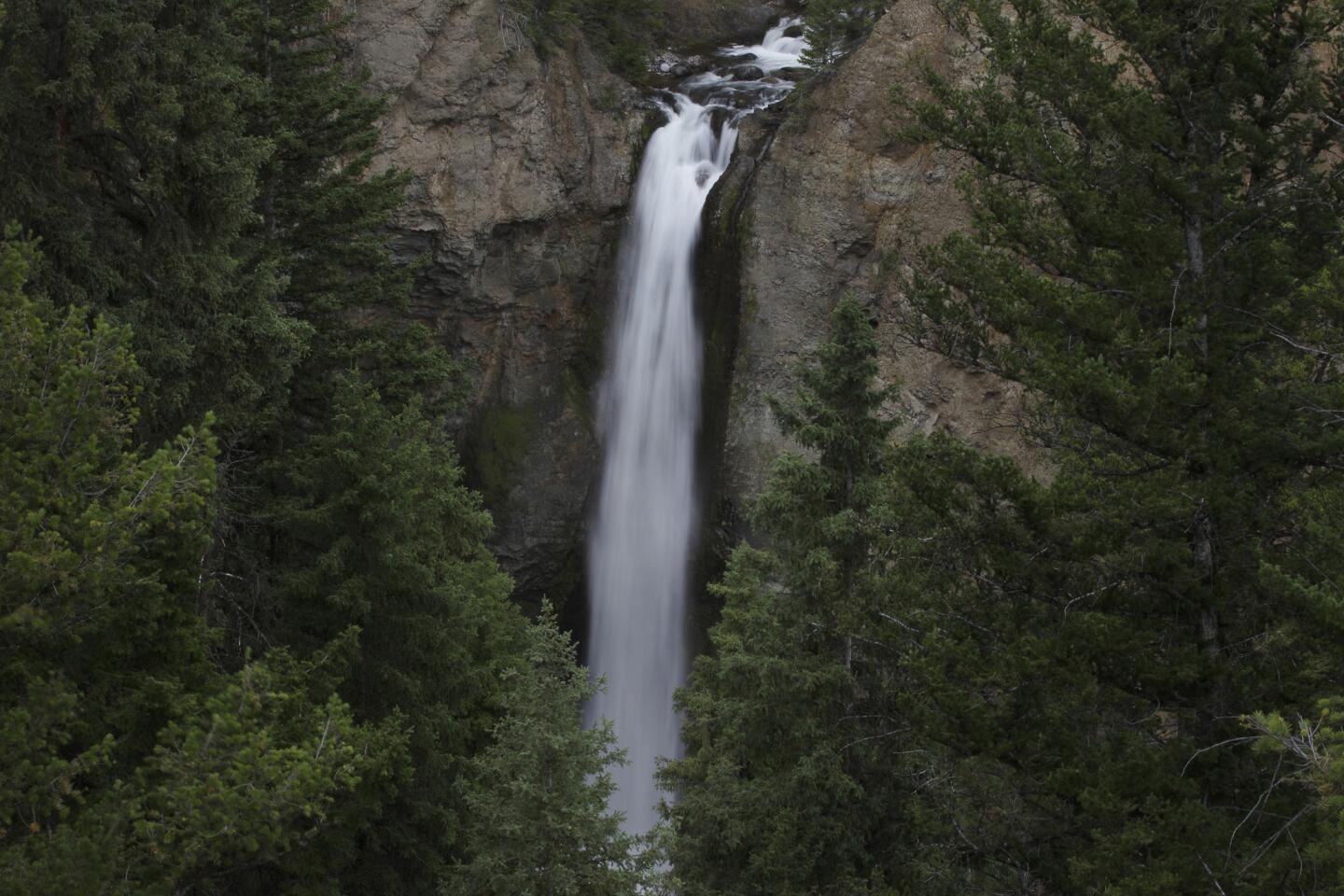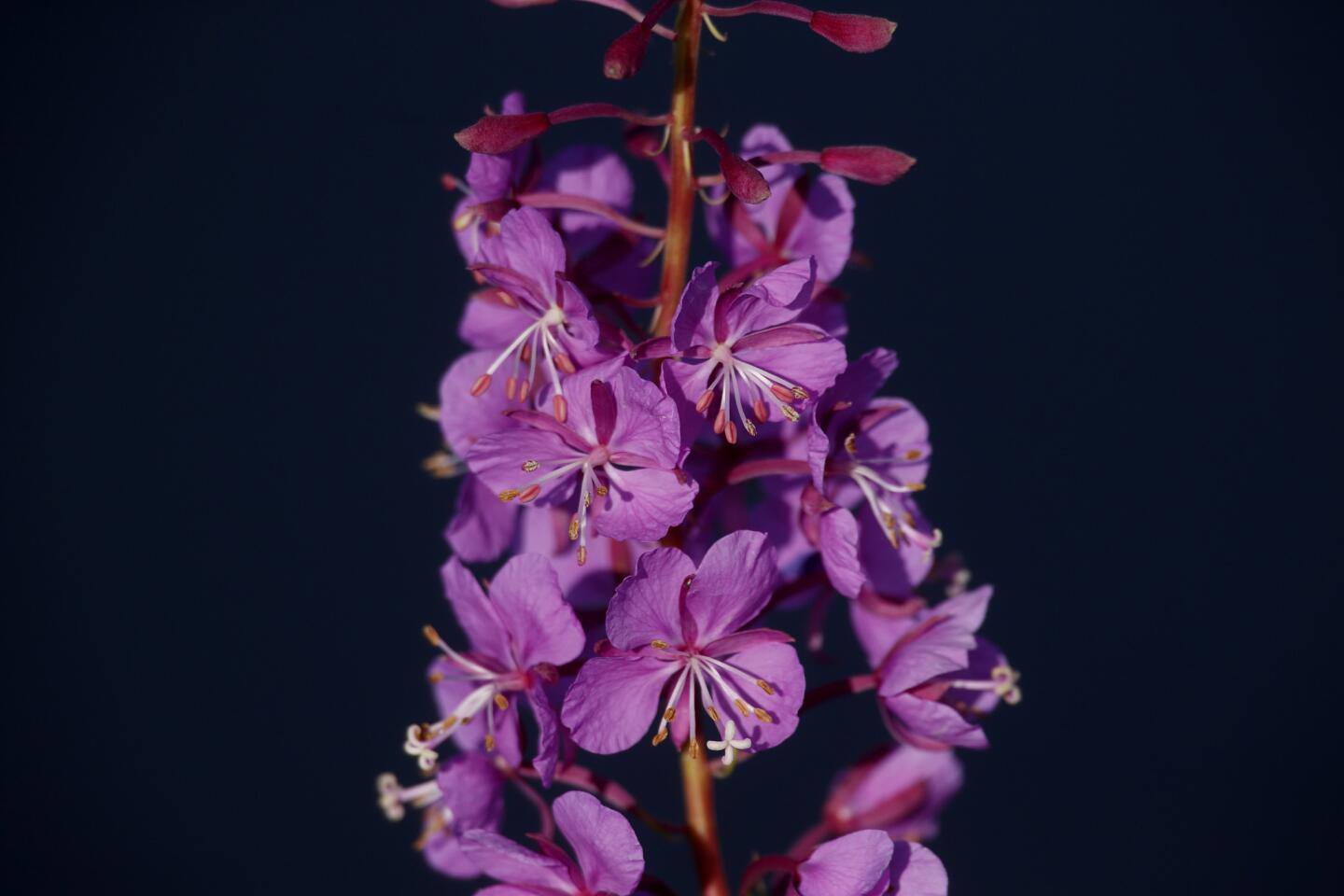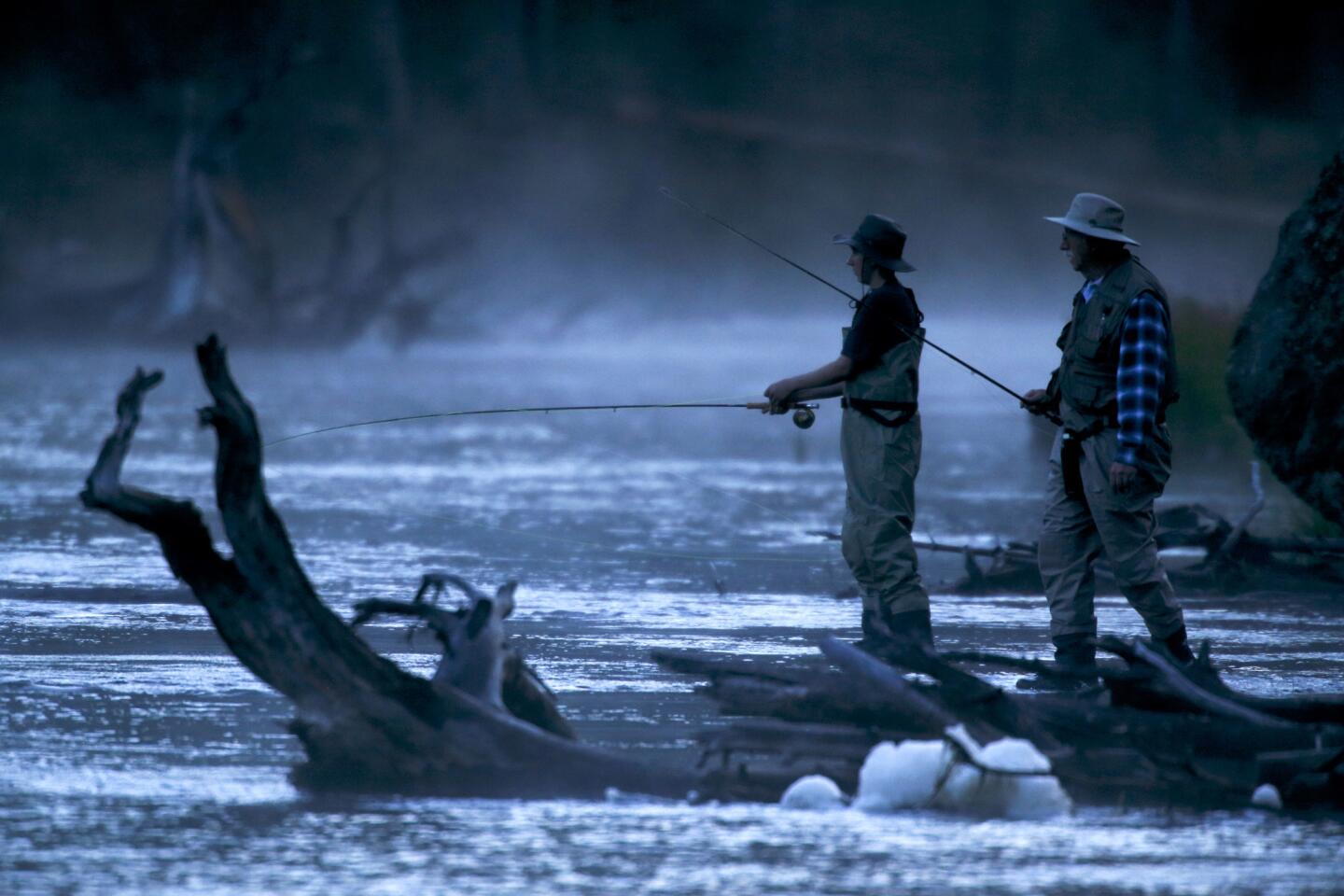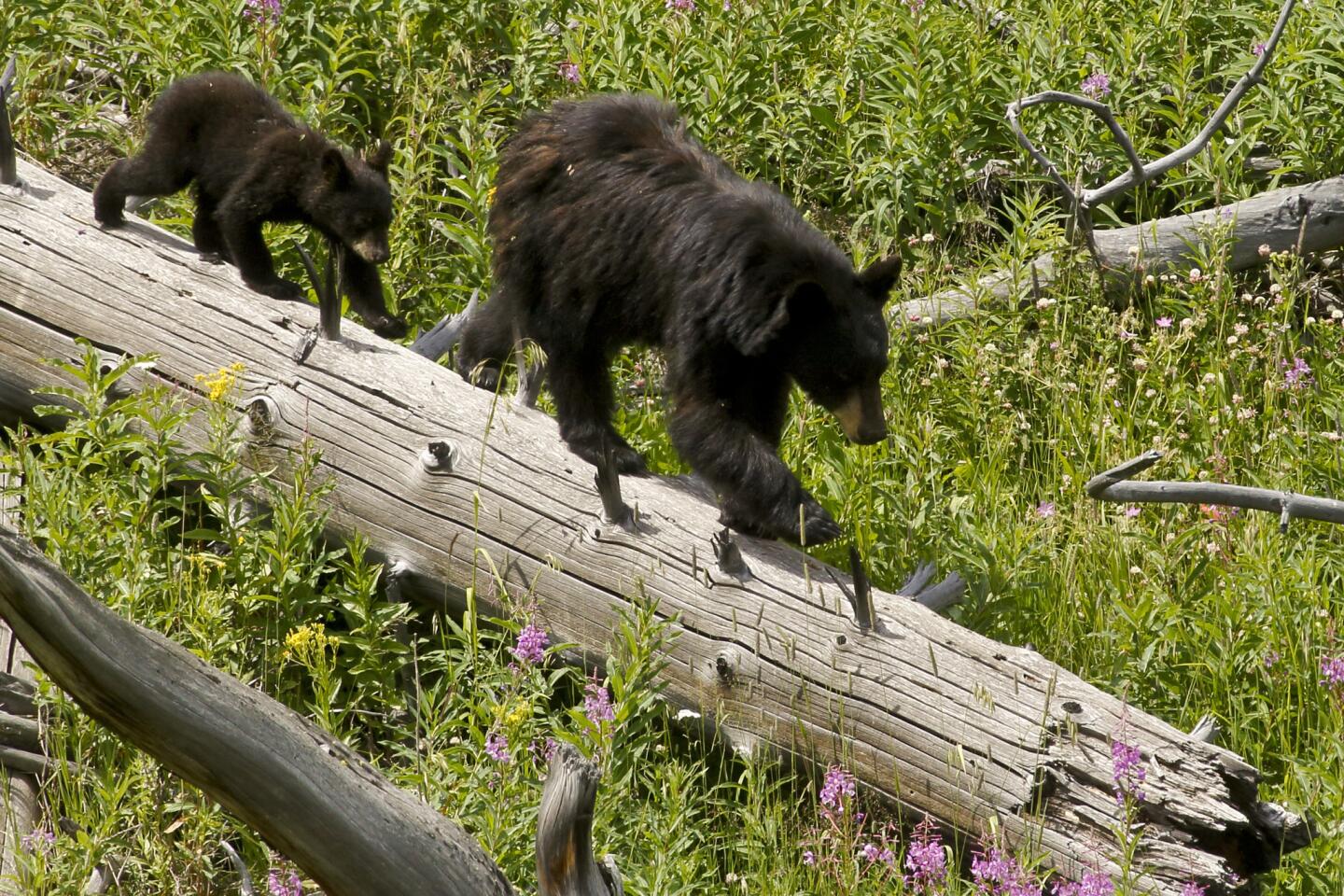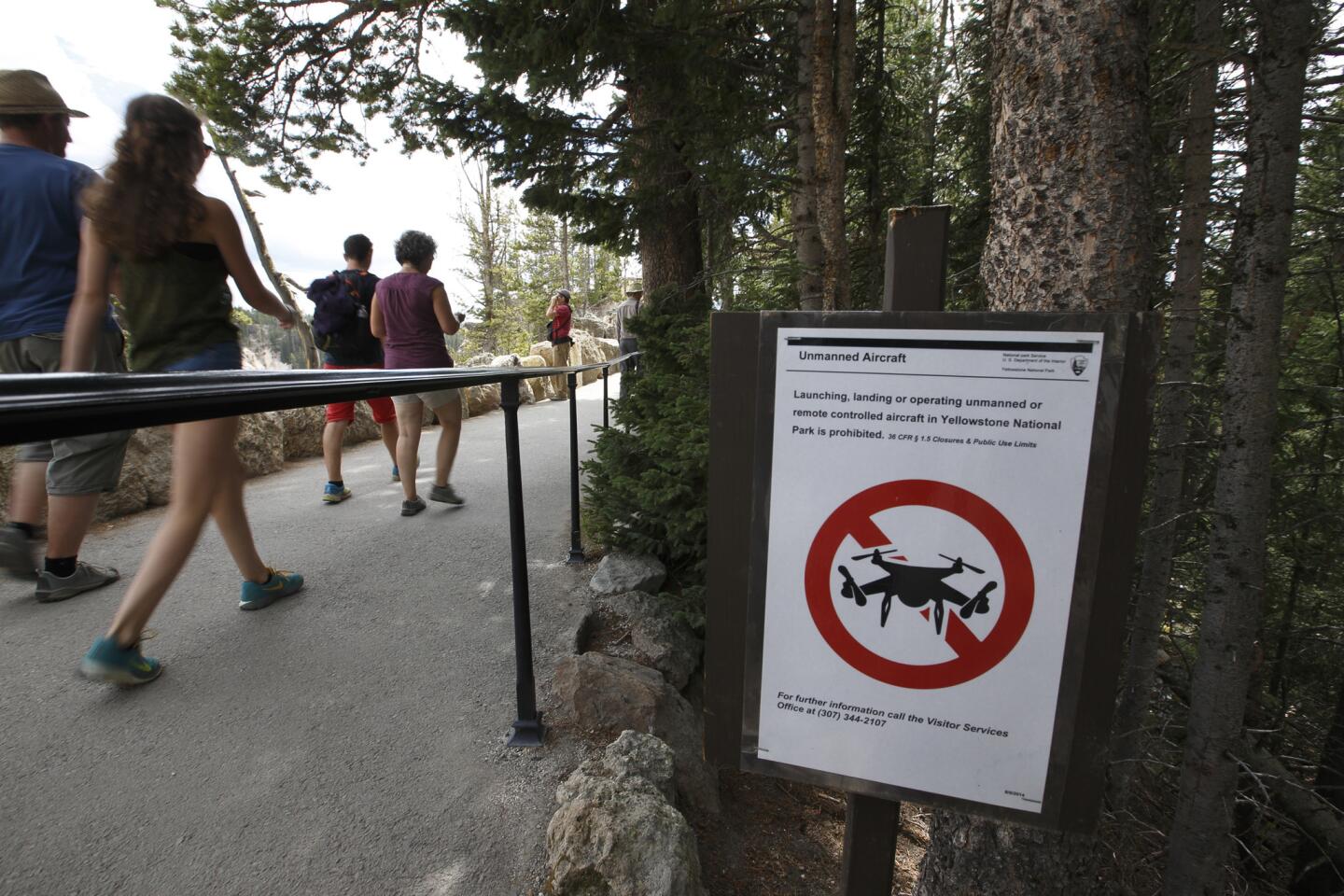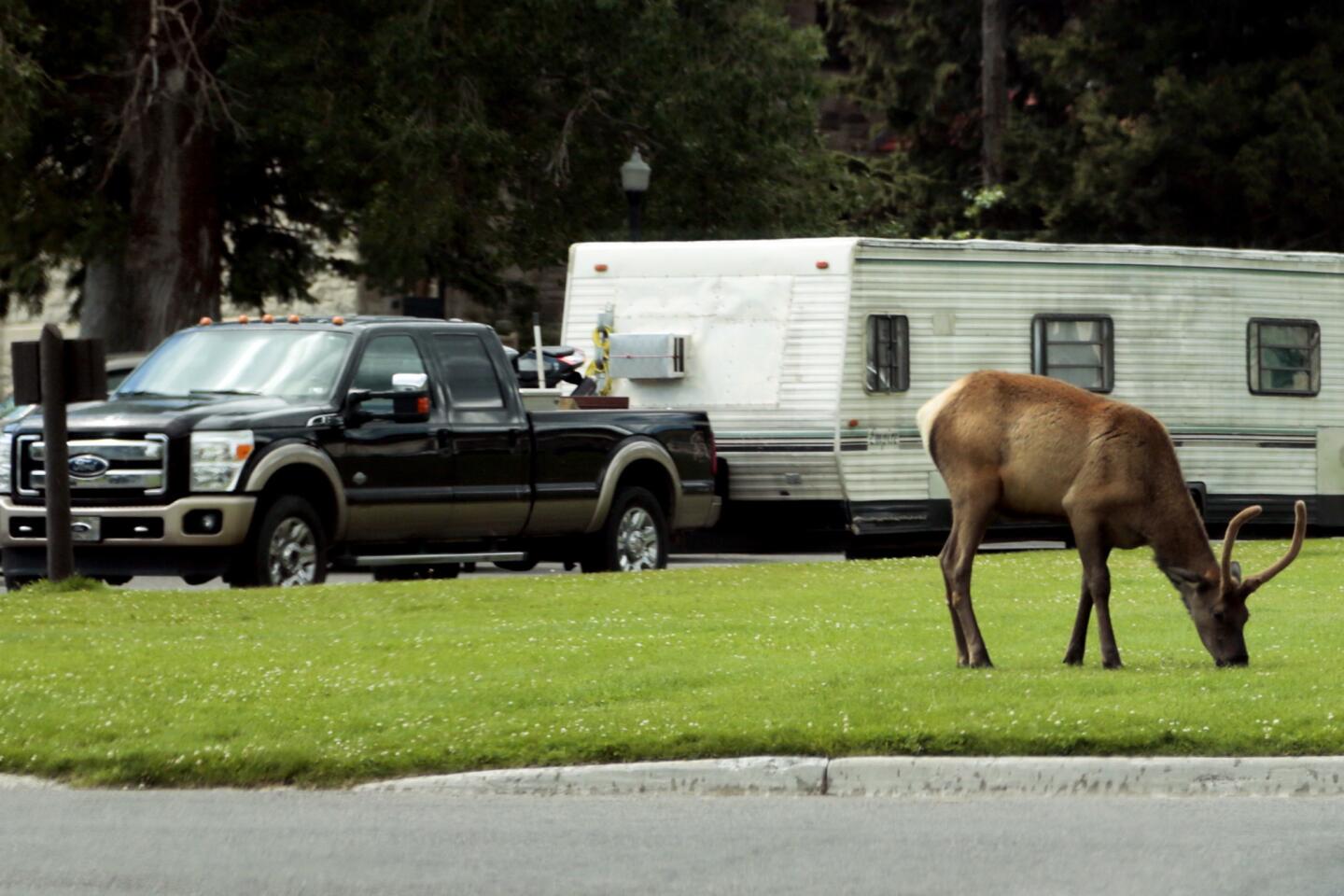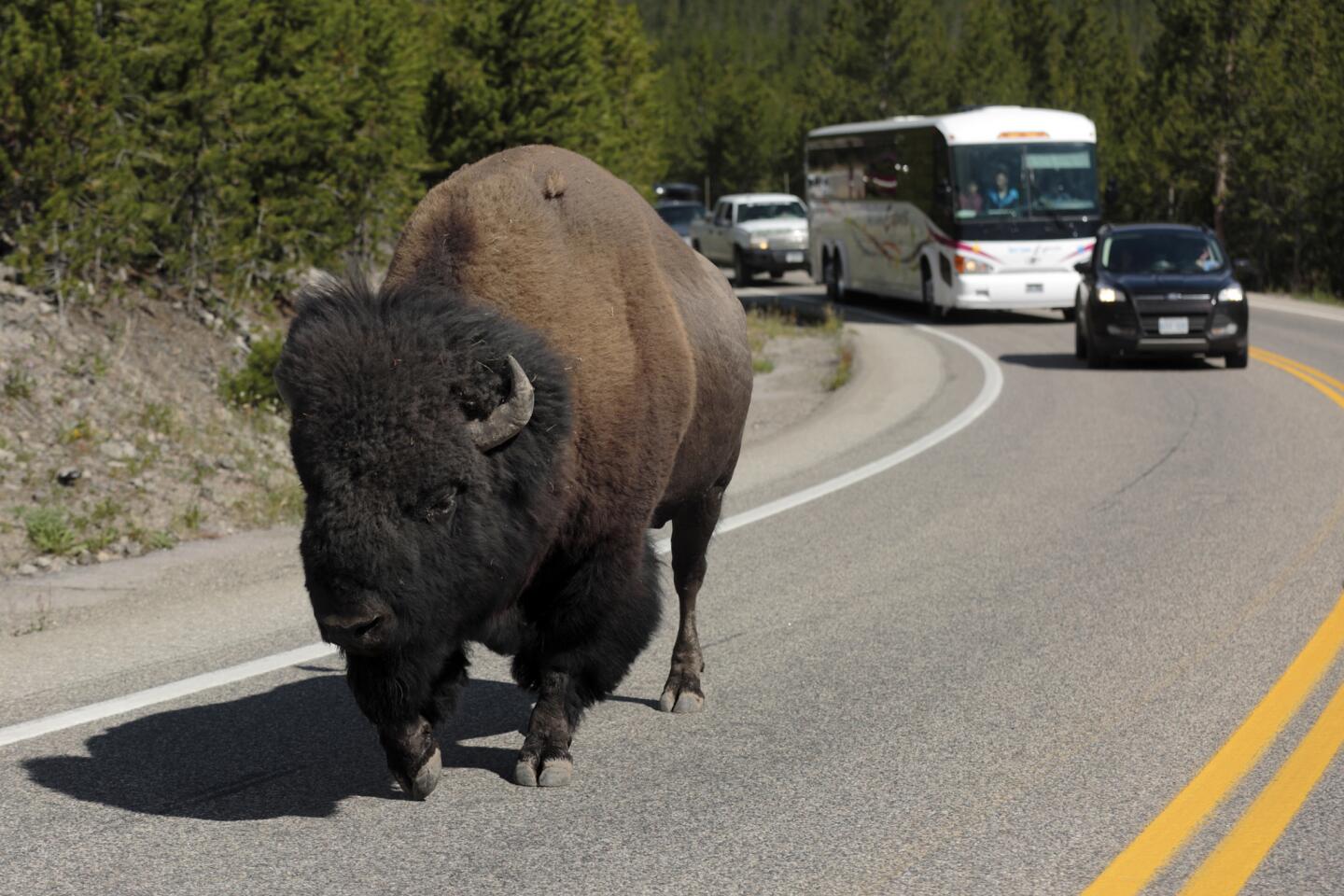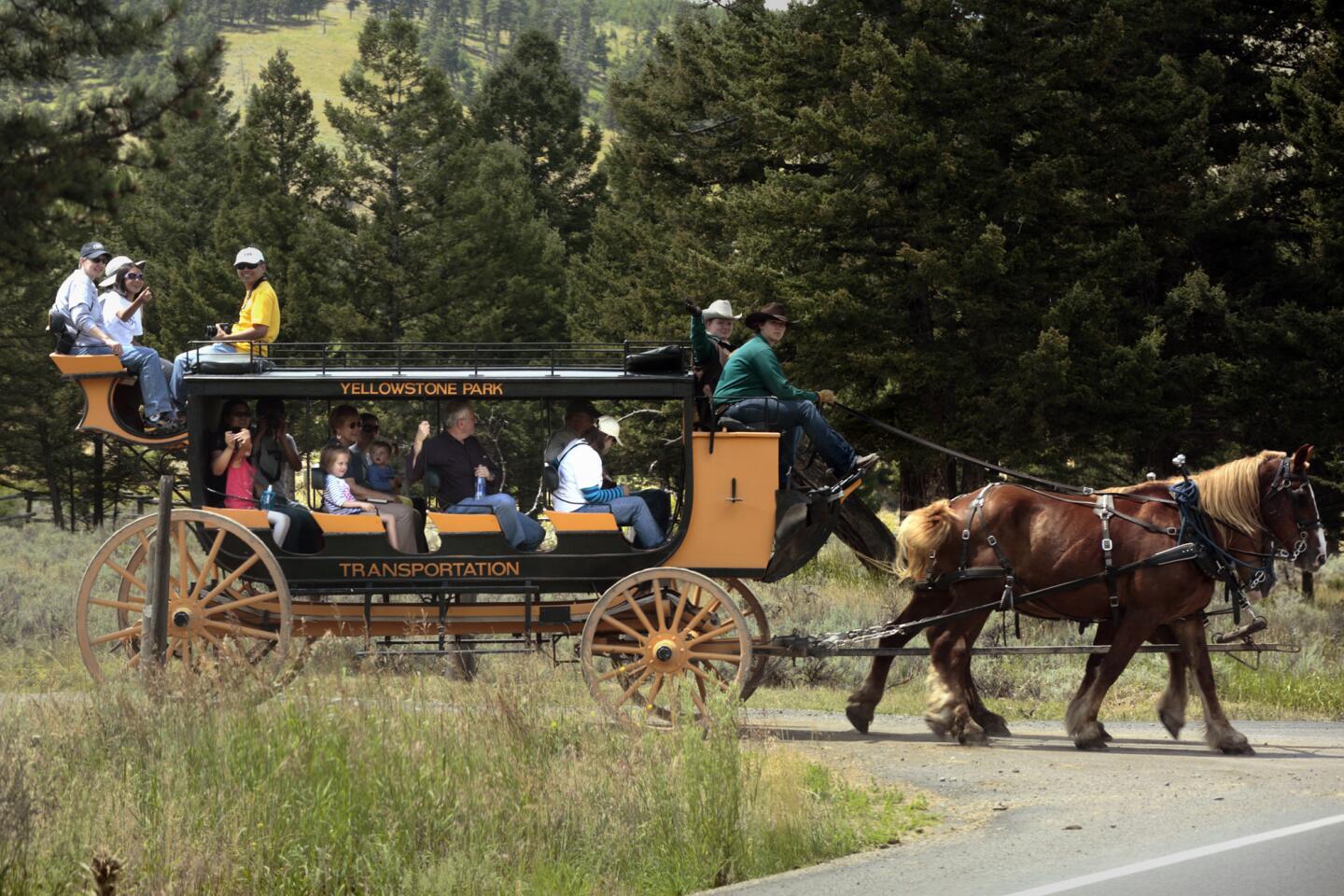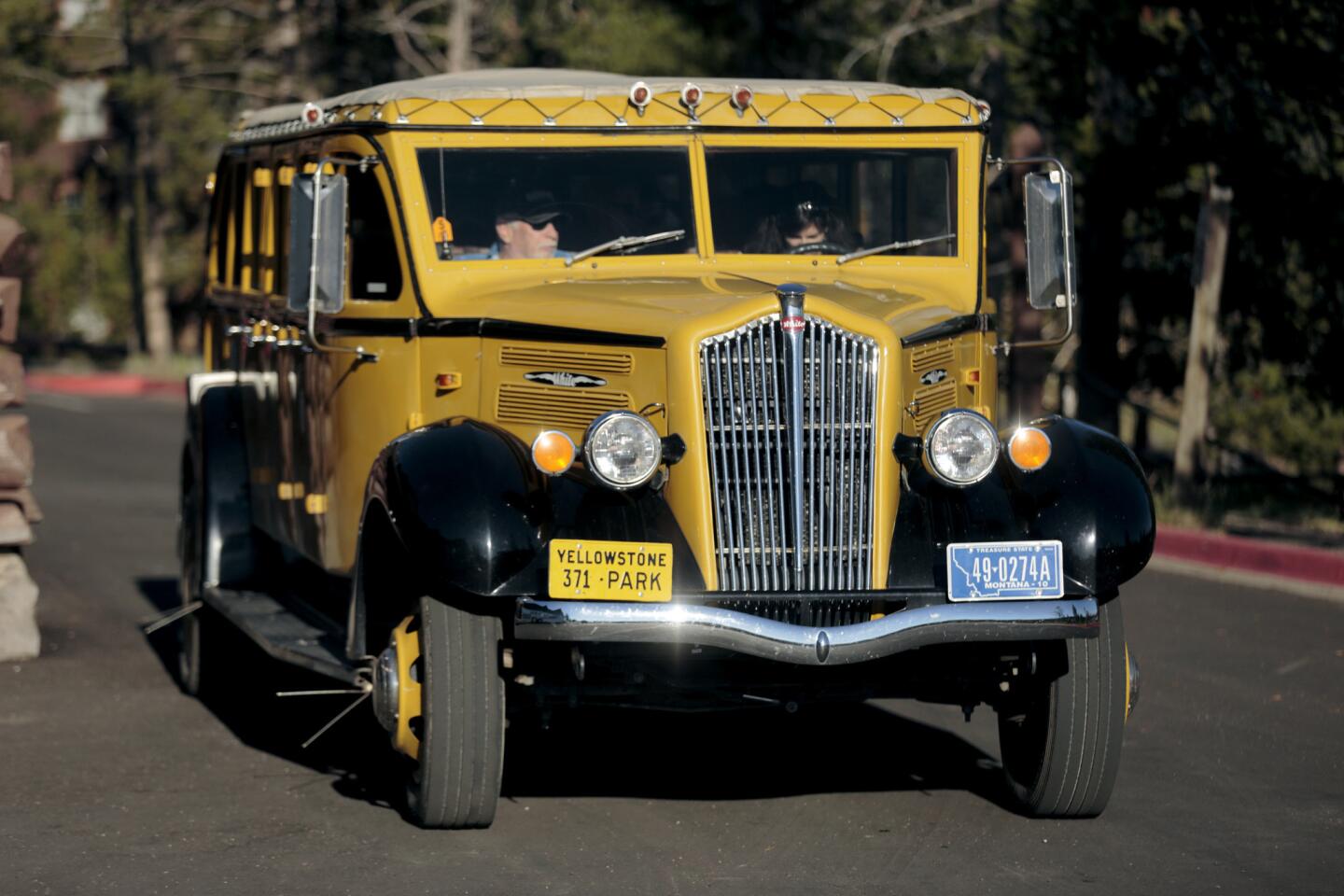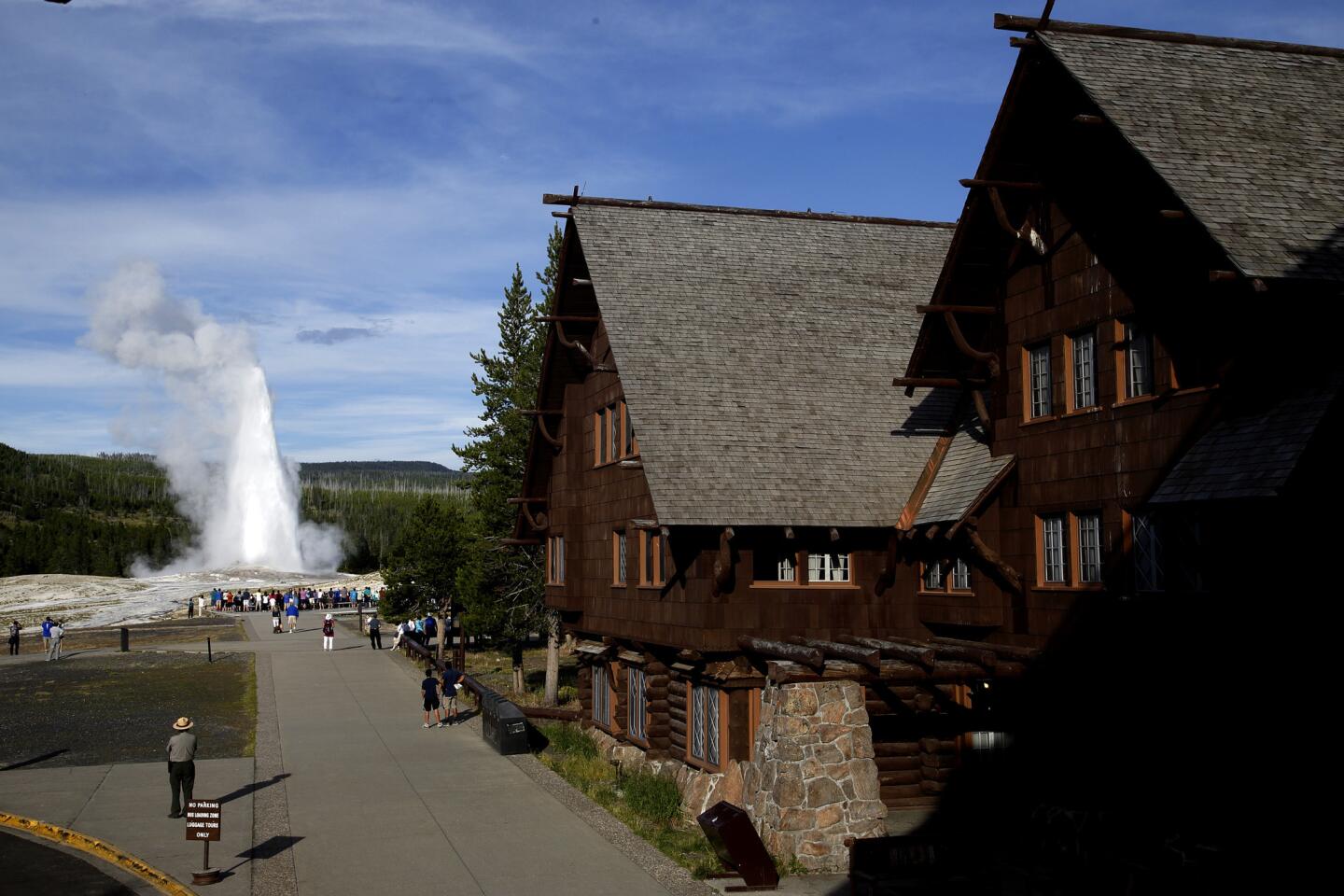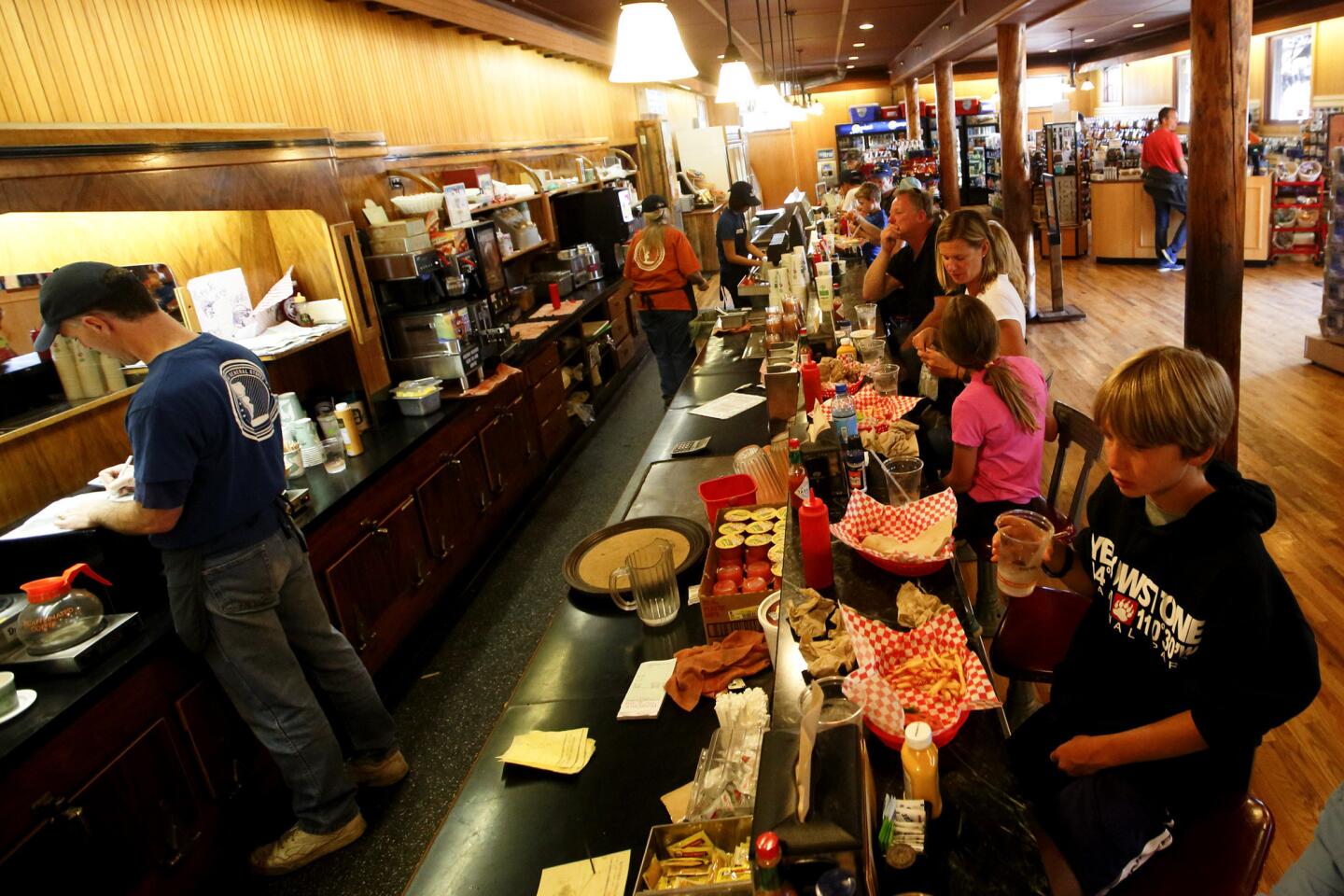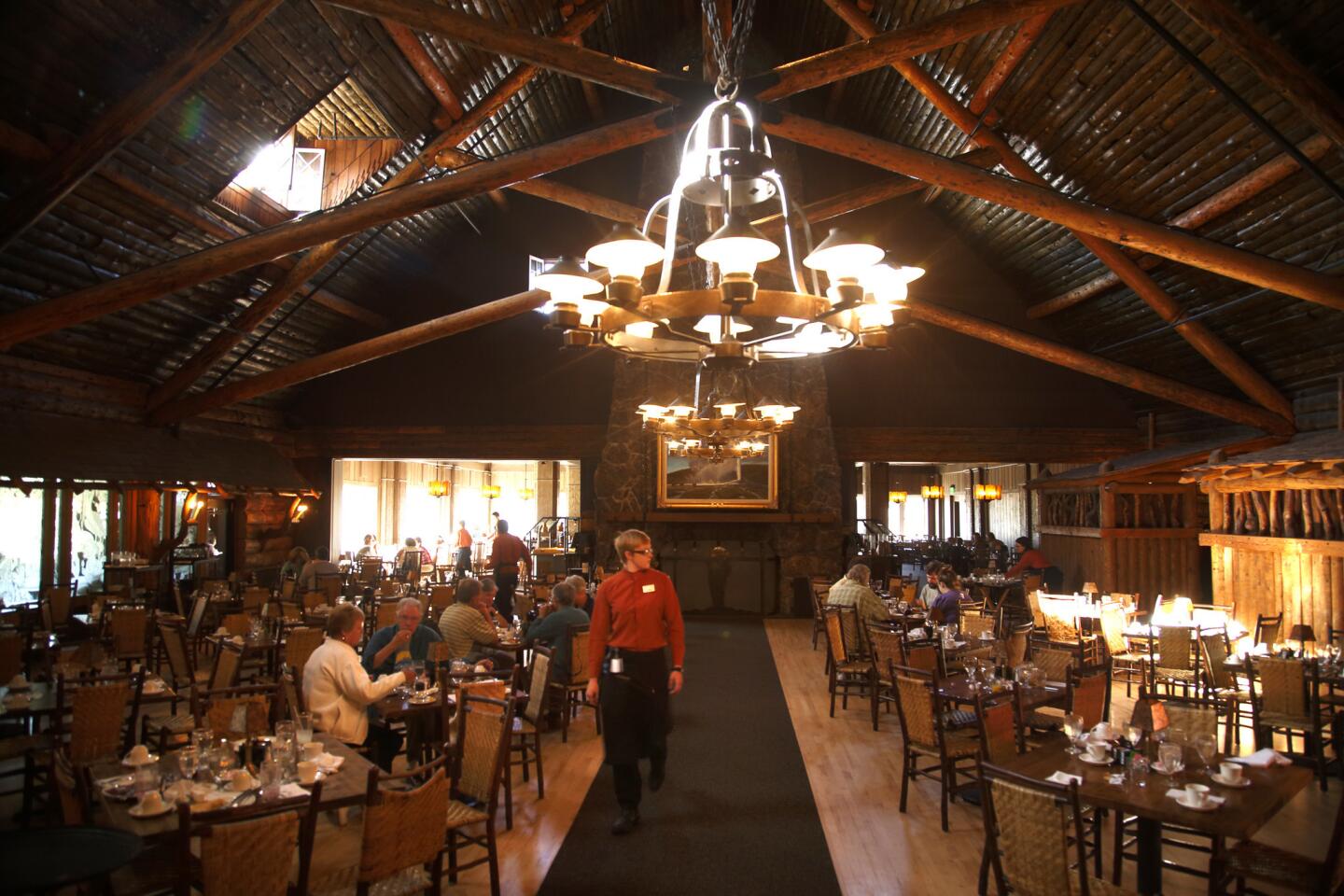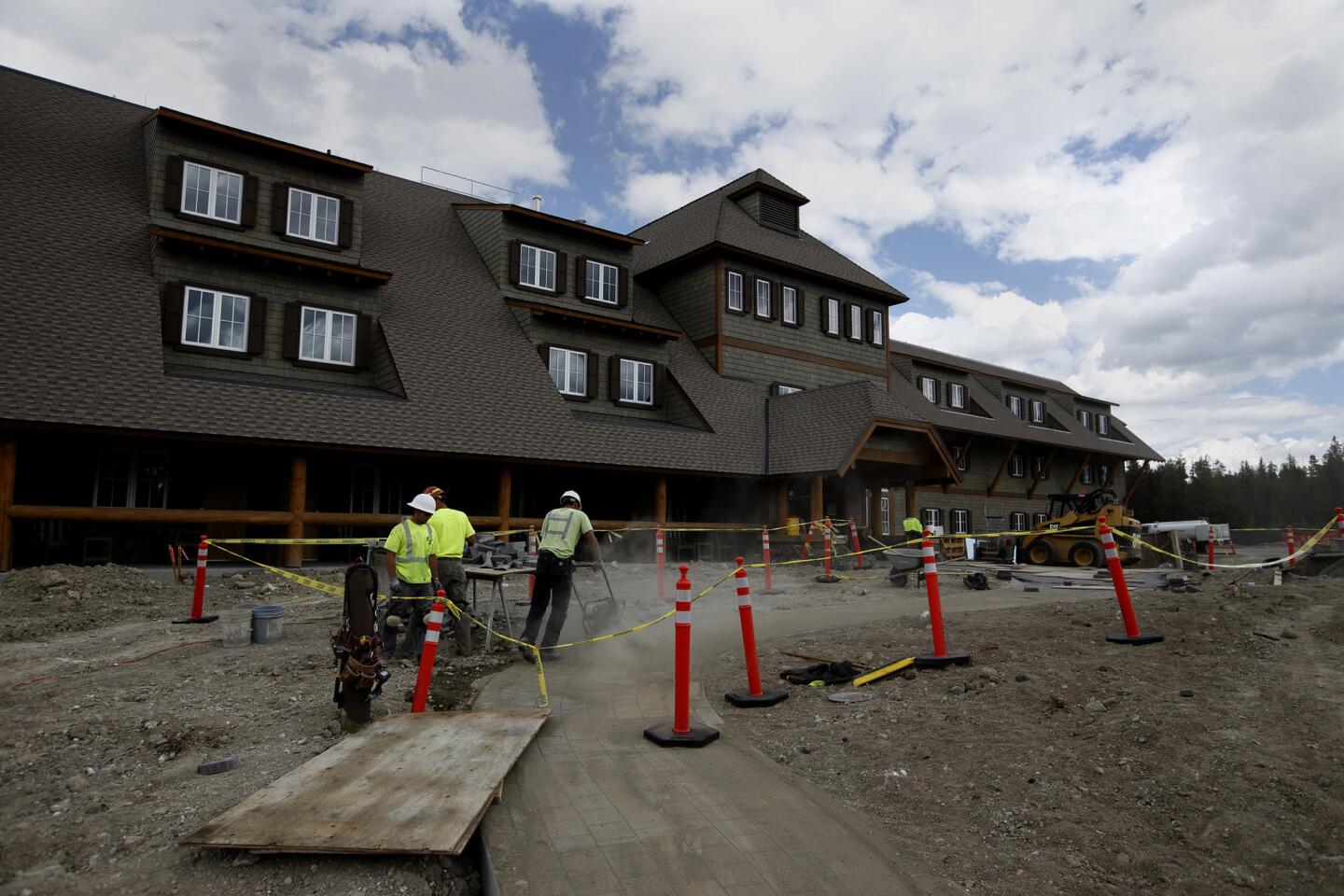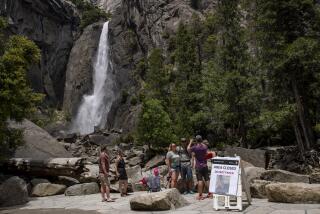Postcards From the West: Yellowstone’s steaming, splashing, roaring spectacle is best seen up close

<p>Yellowstone’s appeal are it’s wildlife and geothermal wonders that could kill you. But in the mean time, they’re beautiful.</p>
- Share via
YELLOWSTONE NATIONAL PARK — Most days, in most ways, this park’s Upper Geyser Basin is a geothermal outlaw biker beach party — belching and splashing at all hours, with a sulfuric whiff of menace riding the breeze.
But in one patch of boiling mud, about 17 times a day, the bubbling becomes something bigger. Heated to 200 degrees or more, the water and steam rise 50, 80, 100 feet and beyond into the vast Wyoming sky.
If it’s a summer day, the surrounding boardwalk and benches will be teeming with travelers from Chula Vista, Chicago, China and thousands of other places where mud doesn’t bubble. As the splashes grow, so do the oohs and ahhs. Sometimes Old Faithful blows for just 90 seconds, sometimes for a full five minutes.
Either way, it’s one of the most thrilling scenes in North America. There’s no telling what fiery volcanic catastrophe might someday erupt in Yellowstone, but for now, this geyser masks that menace as a charming little ritual, a family photo op.
That’s part of Yellowstone’s appeal. Its beasts and geothermal wonders could kill you or bury several states in ash. But in the meantime, they’re beautiful.
And — except for the bison that dawdle in the middle of Grand Loop Road — they usually don’t stand still. Two black bear cubs scamper behind their mother across a meadow near Roosevelt Lodge. A rainbow flickers above the Lower Falls in the Grand Canyon of the Yellowstone. Steam billows from Chinese Spring as dusk falls on a cold, windy day.
In late July I spent four days among these iconic scenes with Times photographer Mark Boster. (Yellowstone is mostly in Wyoming but spills over into Montana and Idaho.) And as I did, my mind kept wandering back to an event in 1871, when photographer William Henry Jackson and painter Thomas Moran arrived here on the first federally funded expedition to document the area.
How much chance did Jackson and Moran have of capturing a landscape so thrumming with motion and color? After all, it took so long to shoot and process an image that 13 black-and-white glass-plate exposures were a long day’s work.
They did their best and took the results to Washington. The next year, Congress voted to make Yellowstone the world’s first national park. (The legislators also agreed to buy a Moran oil painting, “The Grand Canyon of the Yellowstone,” for $10,000.)
These days, the park gets about 3.5 million visitors a year. Every park lodging was sold out when we were there. (In later summer and early fall, your chances of landing a room are better — especially this year, with the opening of 249 new rooms in the park’s central Canyon Lodge area. They’ll stay open through Sept. 20.)
READ MORE FROM THIS SERIES: Postcards from the West
I had been to Yellowstone with my family just five years ago, but I was thrilled again to behold the elk that lounge on the lawns at Mammoth Hot Springs, to spy a dozen bison roaming a ridge above the Hayden Valley, to watch a man, his son and his grandson fly-fishing at dusk on the Madison River.
The massive log architecture and stone fireplace of the Old Faithful Inn, perhaps the most emblematic lodge in the national park system, were as impressive as ever. And even though I knew precisely what was coming at Old Faithful, I had to hang around long enough to see it erupt not once but twice.
I also had to make peace with crowds and crowd behavior. Most visitors, of course, were great, and it makes an American proud to hear the honest enthusiasm and varied accents around Old Faithful at just about any hour. But in those four days I saw an entire family step off the boardwalk to pose for pictures in a dangerous geothermal area; one father helping his son stick his fingers into the water of an off-limits hot spring; and several men and women advancing perilously close to bear and bison.
Then there was the encounter I learned about from rangers: On our second day in the park, a 43-year-old woman from Mississippi approached a bison near the Fairy Falls trailhead, then turned her back on it to take a selfie. The animal stepped forward, lifted the woman with its head and threw her to the ground. Her injuries were minor, rangers said. Hers was the fifth bison-related injury of the summer.
The best way to steer clear of animal attacks, rangers say, is to follow the park’s rules: Stay at least 100 yards away from a bear (especially a mother with cubs) and at least 25 yards from bison or elk.
To steer clear of crowds? Hike more. Drive less. Rise early. Rest at midday. Roam widely in late afternoon and early evening, when many families retreat to dinner.
But keep in mind that it’s possible to have a sublime park experience in the middle of a crowd.
First we passed Excelsior Geyser Crater. Then we strode straight into a great white cloud with a sulfurous stink.
Somewhere before me, I knew, was Grand Prismatic Spring, the largest in the park, about 300 feet across. But where?
Then the wind shifted. Steam and stink vanished. Suddenly I was 20 degrees cooler, with a wraparound view.
The spring began at the boardwalk’s edge with a flat, brown earthen crust, then a soggy orange fringe, a yellow edge and then the spring itself, whose greenish shallows gave way to blue. The deep blue of prisms, of cake frosting, of too much Photoshop. Implausible blue.
Then the hot, stinky cloud swallowed me again, and my only sensory input was the sound of a thousand tourists, murmuring in a dozen languages at the strangeness of it all.
Every time the wind changed, the setting shifted again. One moment, misty, lunar desolation. The next, a boiling blue pool with a forested slope beyond.
I couldn’t get enough. I walked the loop twice. I climbed ridges to the north and south to get different perspectives. And I imagined William Henry Jackson and Thomas Moran at wits’ end, desperate to capture some sliver of this sensory spectacle.
Later I tracked down their photos and paintings and wondered: If color photography and reproduction had been common in the 1870s, would Grand Prismatic Spring have become Yellowstone’s marquee attraction instead of Old Faithful?
It hardly matters. Whether our photo-op tools come from the 19th century or the 21st, we’re all overmatched at Grand Prismatic Spring and at Yellowstone.
If you want the gleaming, belching, splashing, seething, stinking, roaring, growling, menacing essence of the place, you’d better just come and put yourself in the middle of it.
::
A timeline of Yellowstone National Park: From a prehistoric eruption to a modern flood of visitors
About 640,000 years ago: A massive eruption creates the Yellowstone Caldera, profoundly rearranging the landscape that will become the park. Much of the caldera is filled by flowing lava.
About 174,000 years ago: Another Yellowstone volcano eruption (the most recent we know of) reshapes Yellowstone Lake, creating the area now known as West Thumb.
1869: After generations of occupation by native peoples and years of exploration by trappers and other recent arrivals, the Folsom-Cook-Peterson Expedition is first of three to take formal measure of the Yellowstone area.
1870: Members of the Washburn-Langford-Doane Expedition come upon an oddly reliable geyser and name it Old Faithful.
1871: The first Hayden Expedition to Yellowstone brings photographer William Henry Jackson, painter Thomas Moran and sketch artist Henry Elliott.
1872: Inspired by the imagery of Jackson, Elliott and Moran (whose work was backed by the Northern Pacific Railroad), Congress and President Ulysses S. Grant act to make Yellowstone the world’s first national park. Some 300 visitors come in the first year. The amount of money set aside to develop, protect and maintain the park: none.
1883: The Northern Pacific Railroad extends a branch line near the park’s northern entrance, opening a long era of mutual promotion between the railroads and the national western parks.
1886: Because park officials have no resources, the U.S. Army is assigned to operate the 2.2-million-acre park and rebuff poachers, squatters and other scofflaws.
1904: Workers complete Old Faithful Inn, a rustic resort that may be the largest log cabin on Earth, designed by architect Robert Reamer.
1911: The Canyon Hotel, a 400-room Reamer design, is opened to guests. It’s 750 feet long, the biggest building in the park.
1915: Private automobiles are allowed in the park.
1918: The Army leaves and Yellowstone gets its first rangers. They count 21,275 visitors for the year.
1926: The last wolf pack in Yellowstone is killed, though individual wolves remain.
1931: Visitors routinely gather to watch bears feed on garbage in the park’s dump or approach the animals to offer food or take photos. From 1931 through 1969, rangers count an average of 48 bear-inflicted human injuries per year.
1948: Annual visitation reaches 1 million.
1960: The Canyon Hotel burns to the ground.
1970: A new bear management program closes the park’s open-pit garbage dumps to bears and strengthens prohibitions against feeding the animals.
1971: Park offers winter lodging for the first time at Old Faithful Snow Lodge.
1988: Summer fires join to form a conflagration that burns for months and blackens more than 790,000 acres — more than one-third of the park — before rain and snow subdue the flames in September.
1990s: Snowmobiling becomes a popular park pursuit.
2000: Park Service starts phasing out most snowmobile use, citing damage to air quality and natural soundscapes. The move is challenged in court and a long legal battle begins. Snowmobiles and snowcoaches still operate in winter, but with many restrictions.
1995: Gray wolves are reintroduced to the park. As of 2015, rangers estimate more than 300 wolves live in greater Yellowstone.
2011: Since 1980 human injuries from bears are now down to an average of one a year. But danger remains: Two hikers are killed by grizzlies in the park’s Hayden Valley (one in July, one in August), the first bear-caused fatalities since 1986.
2014: About 3.5 million visitors.
Sources: National Park Service, www.lat.ms/1hdauJ8;
U.S. Geological Survey, www.lat.ms/1LzlVYK
Twitter: @mrcsreynolds
ALSO:
Music to watch Old Faithful by
The do’s and don’ts of Yellowstone National Park
Colorful Bozeman, Mont. is a short trip from Yellowstone
More to Read
Sign up for The Wild
We’ll help you find the best places to hike, bike and run, as well as the perfect silent spots for meditation and yoga.
You may occasionally receive promotional content from the Los Angeles Times.
